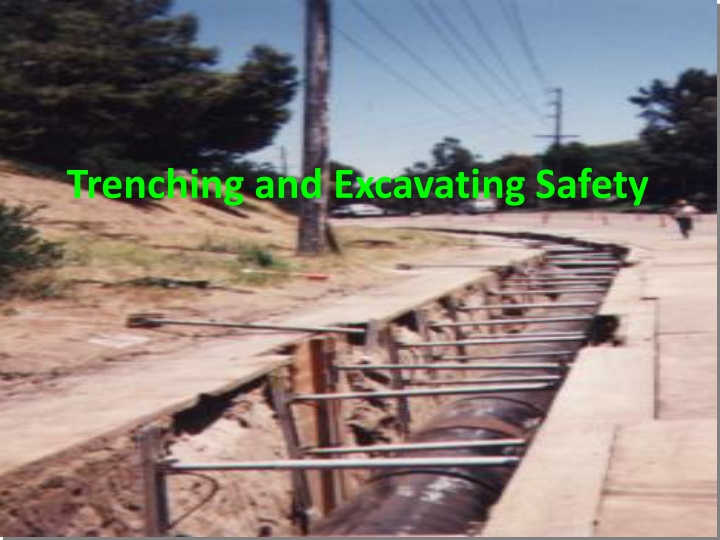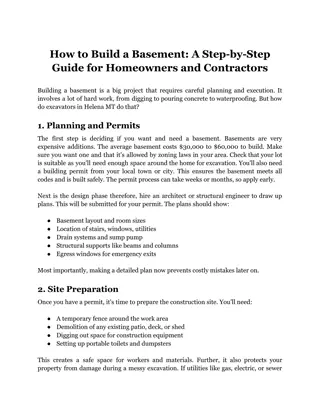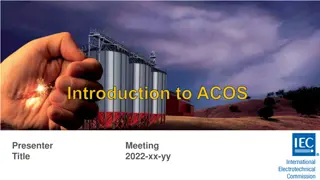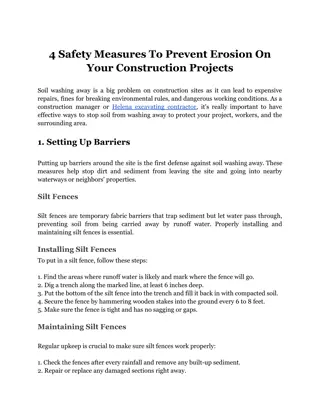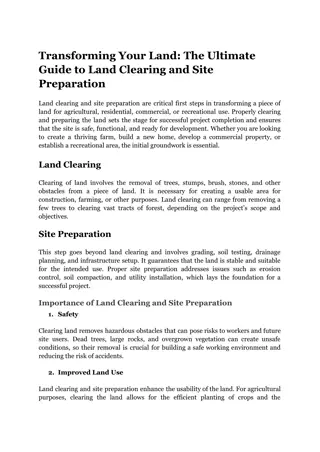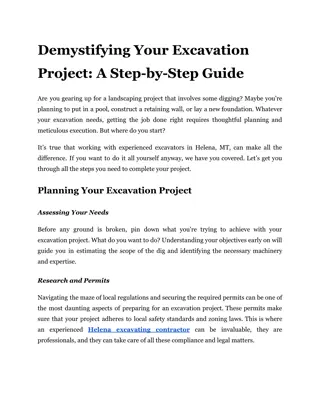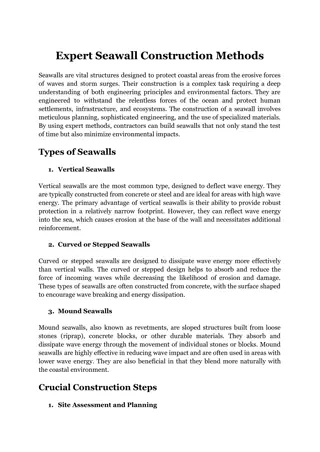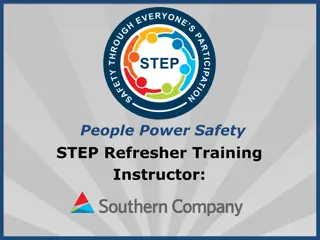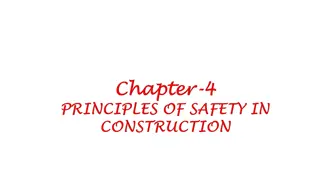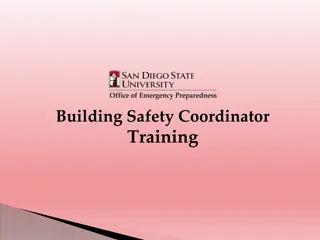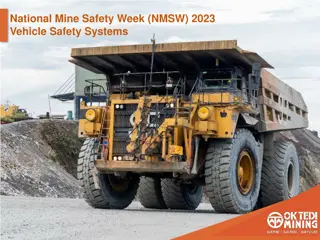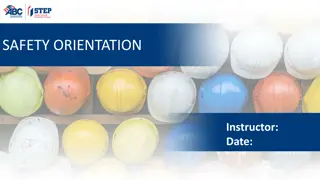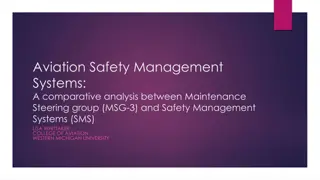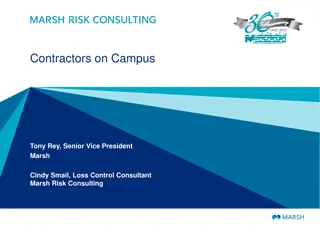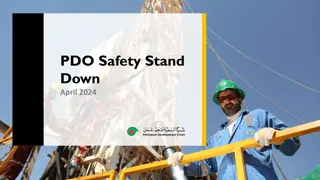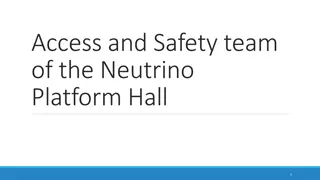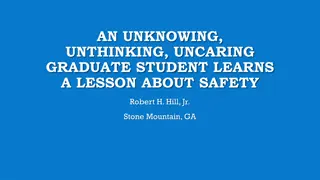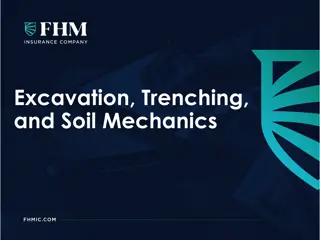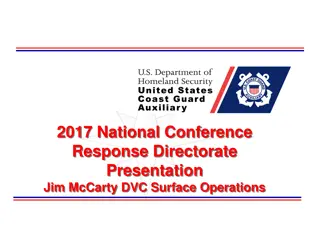Trenching and Excavating Safety Guidelines
Learn about the risks and safety measures involved in trenching and excavating. Understand the causes of death, soil weight impact, cave-ins, common hazards, emergency procedures, safety requirements, and actions to take in case of an emergency.
Download Presentation

Please find below an Image/Link to download the presentation.
The content on the website is provided AS IS for your information and personal use only. It may not be sold, licensed, or shared on other websites without obtaining consent from the author.If you encounter any issues during the download, it is possible that the publisher has removed the file from their server.
You are allowed to download the files provided on this website for personal or commercial use, subject to the condition that they are used lawfully. All files are the property of their respective owners.
The content on the website is provided AS IS for your information and personal use only. It may not be sold, licensed, or shared on other websites without obtaining consent from the author.
E N D
Presentation Transcript
WHAT CAUSES DEATH? Asphyxiation Each time a breath is exhaled the weight of the load restricts inhalation of the next breath. Slow suffocation usually follows unless rescue is immediate.
SOIL WEIGHT? DEPENDING ON THE DENSITY AND WATER CONTENT: One cubic yard weighs - 3000lbs or more One cubic foot weighs - 100lbs or more 3 FEET 1 FOOT 100lbs or more 3000lbs or more
DYNA THINGS THAT CAN CAUSE CAVE-INS CAVE-INS RESULT FROM: Vibrations Adjacent Structures Freezing and Thawing The Weight of the Soil Itself Addition or Removal of Water Reduction in Frictional and Cohesive Capacities of Soil
HOW DO MOST DEATHS OCCUR? Instantaneously Trenches 5 to 15 deep With absolutely no warning In seemingly safe conditions With workers in a bent or lying position
EVALUATING THE SITE BEFORE YOU BEGIN EXCAVATION: The site must be assessed Potential hazards must be determined Known hazards reduced or eliminated Emergency procedures established Periodic inspection intervals determined Utility locations must be staked or marked
SAFETY REQUIREMENTS Conduct inspections before each work shift Do not work under elevated loads Do not work over unprotected employees Wear proper personal protective equipment Provide walkways or bridges over trenches Provide trench exits within 25 feet of workers in trenches more than four feet deep Ensure spoilage is at least 2 ft. from trench edges
WHAT TO DO IN AN EMERGENCY Immediately call 911, or the Emergency Response Team Report: - Exact Location - Number of Victims - Nature of Emergency - Trench Measurements - Special Hazards Keep all life-support and dewatering systems operating Clear workers away from the excavation Shut down heavy equipment Be prepared to meet and brief rescue personnel
IN AN EMERGENCY What not to do: - Don t Panic! - Control would-be rescuers - Don t sacrifice anyone else - Never attempt to dig someone out using motorized equipment Remember - Your actions could save a life!
PROTECTION METHODS ACCIDENT PREVENTION METHODS: Warn and reroute public traffic Post signs, barricades and flagmen Mandate use of reflective vests Warn site traffic Install protective supports systems
UNDERGROUND HAZARDS Utility lines must be located before excavating begins Utility companies or owners must be contacted: -- Response times must be considered -- Advised of the proposed work -- Questions concerning underground installations need to be answered
UNDERGROUND INSTALLATIONS If no response is given within 24 hours* work can cautiously proceed *(local timeframes may vary ND 48 hours) Underground installations must be determined by safe and acceptable means Excavated underground installations must be protected Never under estimate hazards associated with underground utilities!!!
TRENCH SAFETY TRENCHES MORE THAN 5 FEET UNLESS MADE IN STABLE ROCK: Require shoring Or must have a stabilized slope IN HAZARDOUS SOIL CONDITIONS: Trenches under 5 feet need protection
CONTROLLING WATER Adequate Precautions Must Be Taken When Working in Accumulated Water Controlling Water and Water Removal Must Be Monitored by a Competent Person Ditches, Dikes or Comparable Means Should Be Used to Prevent Surface Water From Entering Excavations
SOIL TYPES TYPE A SOILS - Clay - Silty Clay - Sandy Clay - Clay Loam TYPE B SOILS - Granular Cohesionless Soils (Silt Loam) TYPE C SOILS - Gravel - Sand - Loamy Sand
HOW TO DETERMINE SOIL TYPES Continued SOIL CLASSIFICATION MUST BE DONE BY A COMPETENT PERSON: VISUAL TEST Check entire worksite Fissured ground Layered soil Disturbed earth Seepage Vibration Poor drainage
HOW TO DETERMINE SOIL TYPES Manual Test Plasticity Dry Strength Thumb penetration Pocket penetrameter Hand operated shear vane WARNING: One soil inspection and classification may not be enough. Outside disturbances during excavation may change even the best soil classification. Inspect the soil after any change in conditions.
1926 Subpart P Appendix A Soil Classification (c) (2) The classification of the deposits shall be made based on the results of at least one visual and at least one manual analysis
HOW TO PROTECT PEOPLE Each employee must be protected from cave-ins by an adequately designed system. Exceptions are: Excavations made in stable rock Excavations less than 5 feet Protective systems must have the capacity to resist all loads that are expected to be applied to the system
BENCHING AND SLOPING DESIGN OF BENCHING AND SLOPING SYSTEMS: OPTION 1 - Allowable configurations and slopes OPTION 2 - Determination of slopes and configurations using Appendices A and B OPTION 3 - Designs using other tabulated data OPTION 4 - Design by a registered professional engineer
SPOIL PILES Continued 2 FEET MINIMUM
BENCHING AND SLOPING TYPE A SOILS 20 FEET MAX 1 3/4
BENCHING AND SLOPING TYPE B SOILS 20 FEET MAX 1 1
SHIELDING Shield systems must project at least 18 inches above the lowest point where the excavation face begins to slope
